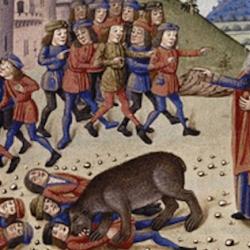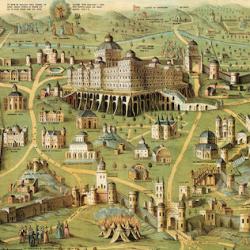1 Kings 12:25-13:34 hangs together as a single unit. The chapter break is very bad. There is a clear inclusion between 12:25-31:3 and 13:33-34. The oracle of the prophet of Bethel in 13:32 brings up the altar in Bethel and the ?houses of the high places?Ethat were mentioned in 12:31, 33. Further, 13:33-34 repeats some things from the 12:30-31 in reverse order. As Jerome Walsh has pointed out, there is a chiastic inclusio around the whole passage:
a. This thing became a sin, 12:30
b. He built houses on high places, 12:31a
c. Made priests from all the people, 12:31b
c. Made priests from among all the people, 13:33a
b. Ordained priests of the high places, 13:33b
a. This became a sin, 13:34a
This might suggest that 12:25-29 is a distinct small section, and that 12:30ff is separate. Though this is possible, it seems rather that the themes of chapter 13 reach back to 12:25. The word ?return?Eis a leitwort throughout chapter 13. The text focuses on the illicit return of the man of God, and verse 33 speaks of Jeroboam?s failure to ?return from his evil way.?EThat theme is already at work in 12:26, where we learn that Jeroboam is concerned because the people might ?return?Eto the house of David. In fact, this theme has been running throughout the Jeroboam story (12:5, 12, 20, 24). Since this is the same word for ?repent,” it appears that there is a pun here. The repetition of the word ?turn?Ealso emphasizes the ?twists and turns?Eof the plot itself.
Mead suggests that the chapter has a panel structure:
a. Man of God against Jeroboam: prophecy against Jeroboam
b. Man of God and old prophet (hears report; saddle)
a?E Old prophet against man of God: prophecy
b?E Man of God and old prophet (hears report, saddle)
If we follow this latter outline, then the man of God?s fate is parallel to the fate of Jeroboam: Both receive a word from Yahweh, and both disobey. This implies that the future of Jeroboam?s house is in jeopardy. The tearing of the altar matches the tearing of the body of the man of God, and both point to the eventual destruction of Jeroboam?s dynasty, which is clearly part of the prophecy of the man of God from Judah.
In his commentary, Walsh suggests a different parallel or panel structure:
a. Prophet hears news
b. Prophet speaks
c. Saddle donkey
d. Finds man of God
e. Man of God returns and eats
f. Prophet prophesies
g. Word is fulfilled
a?E Prophet hears news
b?E Speaks
c?E Sons saddle donkey
d?E Finds man of God
e?E Brings back man of God for funeral
f?E Confirms word of God
The effect of this structure is to leave the story unfinished. In the first sequence, the prophet prophesies that the man of God will not be buried at home, and, though the prophecy does not require an immediate fulfillment, it is immediately fulfilled. In the second, the old prophet confirms the word of the man of God, as a second witness, but we don?t read about any fulfillment, immediate or not. This prophecy is not fulfilled until 2 Kings 23:16ff, which finishes this story. The prophecy, thus, hangs over the whole of Kings, awaiting completion. It is as if we get to the next to last chord of a symphony, and the orchestra just holds that chord. This also suggests something about the nature of Josiah?s ministry, which reverses the effects of Jeroboam?s reign, reuniting the kingdom, leading a ?new conquest?Eto reverse the ?de-conquest?Eof Jeroboam, and destroying the idolatrous shrines where the Kings of Israel committed the ?sin of Jeroboam the son of Nebat.?E
To fill out Walsh’s structure: There appears to be a triple structure, giving the story a cyclical shape. A report comes at the old prophet?s house, which he hears a report from his ?sons?E(perhaps prophets-in-training rather than actual biological sons). Then the man of God receives a word from the Lord through the old prophet, and the old prophet gets a report from the people of the city (vv. 11, 20-22, 26). The donkey is saddled three times (vv. 13, 23, 27). Then, someone goes out from the old prophet?s house: first, the old prophet himself, then the man of God, and finally the old prophet again (vv. 13, 24, 28). Someone or something ?finds?Ethe man of God. The old prophet finds him under a tree, the lion finds him on the road, the old prophet finds his body along the road (vv. 14, 24, 28). In the first and third sequence, there?s a return. The man of God returns to eat and drink in the house of the old prophet, and in the last the old prophet brings the body of the man of God back to his home (vv. 14-19, 29). The whole passage is constantly returning, moving back to Bethel, and the word return is used repeatedly. The sequence in each case concludes with some event. The first and third conclude with an event at the old prophet?s house, first for a meal and then for a funeral. The middle cycle stands in contrast. The lion and donkey stand around the man of God thrown on the ground, and there is no meal (vv. 19, 25, 28, 31-32).
Thus, the repeated pattern is:
Report to old prophet
Donkey saddled
Departure from the old prophet?s house
Finding
(Return)
Event (Meal, funeral)
Several insights may emerge from this cyclical structure. First, the repetition of the sequences highlights the fact that there?s a cause-and-effect connection between the different series. The man of God?s disobedience in the first sequence leads to his death in the second, and that culminates with his burial. First comes the seduction, and then the lion. The tempter comes as an angel of light (claiming to have seen an angel), or as a serpent, sly and cunning; eventually, it leads to death. Second the fact that the man of God?s departure is nestled within two references to the old prophet?s departure from his house suggests some kind of parallel between the two men. This is borne out in a number of ways in the passage. The man of God from Judah ends up on the old prophet?s donkey, and in his saddle (v. 23). The man of God from Judah is called the old prophet?s ?brother?Eat the funeral (v. 30). The man of God ends up in the old prophet?s own grave (v. 31). More subtly, the terminology that describes the two men shifts at the center of the story. Verse 21 is the last time the man of God from Judah is called that, and in verse 23 the old prophet saddles the donkey for ?the prophet whom he had brought back.?EThe two principal characters have shifted places: The old prophet is doing what his ?sons?Ehave been doing, and the man of God is called a ?prophet.?EThroughout the rest of the passage, he is simply the ?man of God?Eor, ironically, the ?man of God who rebelled against the mouth of Yahweh?Einstead of the ?man of God who came from Judah?E(v. 21). This suggests some kind of substitutionary event here: The man of God from Judah changes places with the old prophet of Bethel. After he has eaten and drunk at the house of the old prophet (v. 23), after being joined into ?one flesh?Ewith the old prophet by eating and drinking at his table and in his house and by joining himself to the prophet in disobedience to the Lord?s command, he suffers the punishment from God. But it appears to be a punishment as a substitute for the prophet.
This helps us understand the feeling of injustice that we get from the story. The old prophet is the one who lies. He?s the tempter; but he gets off scot free, suffering absolutely no consequences. How can that be just? Because the man of God from Judah has taken his place. (The problem, of course, is that the man of God is not a sinless substitute. But that is true of all Old Testament ?types?Eof the final ?man of God from Judah?Ewho bears the sins of all Israel.)















